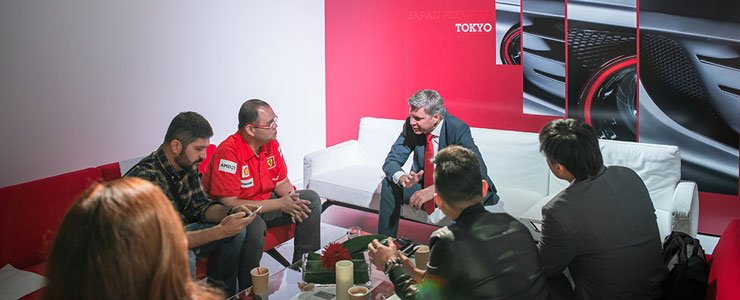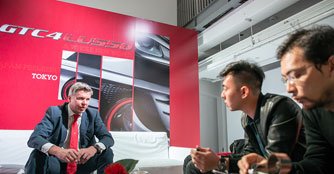Let's talk about Ferrari
19 May 2016|7,593 views
During our recent trip to Tokyo, Japan, for the Far East debut of the Ferrari GTC4Lusso, we caught up with Dieter Knechtel (DK), Managing Director of Ferrari Far East and managed to find out more about the brand's new four-seater and what the future holds for them.
SGCM: Thanks for meeting us, Dieter. For starters, how much does the Asian market contribute to Ferrari's sales?
DK: Asia makes up about 22 percent of Ferrari's sales, with Japan as the leader. Our biggest market is the U.S.A, U.K. is second, and Germany third. Japan used to own the number three spot until recently.
SGCM: Everyone knows that Ferrari is an exclusive brand, so which is more important to you guys - sales volume and profits, or exclusivity?
DK: Ferrari intends to improve its volume, from 7,600 last year to 7,900 this year but we don't plan to change our business model. An increase in sales is good, but exclusivity is still Ferrari's modus operandi and we will never give that up.
SGCM: How popular was the Ferrari FF, the carmaker's first production four-wheel drive model with a body style that's been described as a shooting brake?
DK: When the FF was launched five years ago, it was created as a complimentary model for customers who were looking for something different, made particularly for customers who want a high-performance car that's versatile. We understand that such a car won't suit everyone's taste buds. The FF does, however, have a stronger presence in some markets like Europe. In Asia, we believe there is growing potential for cars of this shooting brake concept.
SGCM: How do you think the GTC4Lusso will do compared to its predecessor?
DK: We expect more sales from the GTC4Lusso than the FF because we have spoken to customers and acknowledged their feedback. The interior of the FF was perceived as too 'average' and that's now being taken care of.
Currently, most of our customers say that they weren't particularly fond of the FF but they've taken a liking to the GTC4Lusso.
SGCM: What is your opinion on FF or GTC4Lusso owners? Do they tend to be older?
DK: Contrary to popular belief, the FF was a car that attracted younger buyers. The average age of FF owners is 45-years old, while the owners of the car before, the Ferrari 612 Scaglietti, was 55-years old. That's an age gap of 10 years. So to answer your question, I believe that the GTC4Lusso might attract an even younger crowd because it looks younger, sportier and is more powerful.
SGCM: Is there any particular market that heavily influenced the design of the GTC4Lusso?
DK: When it comes to the design process, there is an international design team that works on the project. Inspiration is taken from global trends and customer feedback. It's important to understand trends from all over the world but there isn't a particular market that can heavily influence the design on its own.
 |
SGCM: Out of curiosity, how's life like in the back of the GTC4Lusso?
DK: Of course, we are not talking about the spaciousness of a sedan. Your knees will probably touch the seats in front, but comfortable enough.
SGCM: Sport Utility Vehicles (SUVs) are the current hot-sellers and competitors like Bentley and Porsche have jumped on that bandwagon. Will we see an SUV from Ferrari?
DK: You can say that the GTC4Lusso is Ferrari's interpretation of a car that offers four-wheel drive, four seats and the highest level of performance and handling. Ferrari isn't going to enter the standard market with a product like an SUV. It's not part of our DNA. Ferrari makes cars that are fast, light and as sporty as possible.
SGCM: Do you think there's space in the Ferrari family for another model like Porsche's mid-engine two-seater Boxster?
DK: It's very difficult at this point in time to speculate this. It's usually with a group of customers that these discussions take place. From what I know or believe, this isn't something we're exploring at the moment. We are focusing on the existing model range and how to improve or replace them.

DK: Yes, our twin-turbocharged V8 engines are something the world can expect to see more of. But big naturally aspirated V12 engines represent Ferrari and what it does, so it's not something that will ever be completely replaced.
SGCM: What about hybrid technology - is that something that Ferrari will increasingly employ?
DK: Well, we have used hybrid technology in our LaFerrari and I believe that Ferrari has strong knowledge of hybrid powertrains, but adopting that for the rest of our range isn't planned at this point in time.
SGCM: What, then, is the next big thing in terms of technology that we can expect from Ferrari?
DK: I think Ferrari is in many ways very consistent and traditional with what we do. With future models, you can expect more technology and innovation from our Formula One cars. Ferrari needs to be, wants to be, and will continue to be a trendsetter in design. But above all, performance is our priority. We focus on consistent evolution rather than revolution.
During our recent trip to Tokyo, Japan, for the Far East debut of the Ferrari GTC4Lusso, we caught up with Dieter Knechtel (DK), Managing Director of Ferrari Far East and managed to find out more about the brand's new four-seater and what the future holds for them.
SGCM: Thanks for meeting us, Dieter. For starters, how much does the Asian market contribute to Ferrari's sales?
DK: Asia makes up about 22 percent of Ferrari's sales, with Japan as the leader. Our biggest market is the U.S.A, U.K. is second, and Germany third. Japan used to own the number three spot until recently.
SGCM: Everyone knows that Ferrari is an exclusive brand, so which is more important to you guys - sales volume and profits, or exclusivity?
DK: Ferrari intends to improve its volume, from 7,600 last year to 7,900 this year but we don't plan to change our business model. An increase in sales is good, but exclusivity is still Ferrari's modus operandi and we will never give that up.
SGCM: How popular was the Ferrari FF, the carmaker's first production four-wheel drive model with a body style that's been described as a shooting brake?
DK: When the FF was launched five years ago, it was created as a complimentary model for customers who were looking for something different, made particularly for customers who want a high-performance car that's versatile. We understand that such a car won't suit everyone's taste buds. The FF does, however, have a stronger presence in some markets like Europe. In Asia, we believe there is growing potential for cars of this shooting brake concept.
SGCM: How do you think the GTC4Lusso will do compared to its predecessor?
DK: We expect more sales from the GTC4Lusso than the FF because we have spoken to customers and acknowledged their feedback. The interior of the FF was perceived as too 'average' and that's now being taken care of.
Currently, most of our customers say that they weren't particularly fond of the FF but they've taken a liking to the GTC4Lusso.
SGCM: What is your opinion on FF or GTC4Lusso owners? Do they tend to be older?
DK: Contrary to popular belief, the FF was a car that attracted younger buyers. The average age of FF owners is 45-years old, while the owners of the car before, the Ferrari 612 Scaglietti, was 55-years old. That's an age gap of 10 years. So to answer your question, I believe that the GTC4Lusso might attract an even younger crowd because it looks younger, sportier and is more powerful.
SGCM: Is there any particular market that heavily influenced the design of the GTC4Lusso?
DK: When it comes to the design process, there is an international design team that works on the project. Inspiration is taken from global trends and customer feedback. It's important to understand trends from all over the world but there isn't a particular market that can heavily influence the design on its own.
SGCM: Out of curiosity, how's life like in the back of the GTC4Lusso?
DK: Of course, we are not talking about the spaciousness of a sedan. Your knees will probably touch the seats in front, but comfortable enough.
SGCM: Sport Utility Vehicles (SUVs) are the current hot-sellers and competitors like Bentley and Porsche have jumped on that bandwagon. Will we see an SUV from Ferrari?
DK: You can say that the GTC4Lusso is Ferrari's interpretation of a car that offers four-wheel drive, four seats and the highest level of performance and handling. Ferrari isn't going to enter the standard market with a product like an SUV. It's not part of our DNA. Ferrari makes cars that are fast, light and as sporty as possible.
SGCM: Do you think there's space in the Ferrari family for another model like Porsche's mid-engine two-seater Boxster?
DK: It's very difficult at this point in time to speculate this. It's usually with a group of customers that these discussions take place. From what I know or believe, this isn't something we're exploring at the moment. We are focusing on the existing model range and how to improve or replace them.

SGCM: Does Ferrari plan to increase its use of smaller displacement engines across the range in the future, just as it did with the 488 GTB?
DK: Yes, our twin-turbocharged V8 engines are something the world can expect to see more of. But big naturally aspirated V12 engines represent Ferrari and what it does, so it's not something that will ever be completely replaced.
SGCM: What about hybrid technology - is that something that Ferrari will increasingly employ?
DK: Well, we have used hybrid technology in our LaFerrari and I believe that Ferrari has strong knowledge of hybrid powertrains, but adopting that for the rest of our range isn't planned at this point in time.
SGCM: What, then, is the next big thing in terms of technology that we can expect from Ferrari?
DK: I think Ferrari is in many ways very consistent and traditional with what we do. With future models, you can expect more technology and innovation from our Formula One cars. Ferrari needs to be, wants to be, and will continue to be a trendsetter in design. But above all, performance is our priority. We focus on consistent evolution rather than revolution.
Thank You For Your Subscription.



























